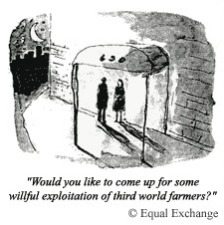Consumption
In the early records of the North American colonies, there is no mention of coffee. 1668 marks the first reference to coffee. The first license to sell coffee was issued to Dorothy Jones in Boston in 1670. By the turn of the century, coffeehouses made appearances and became centers of social, political and business interactions. The first coffeehouse was established in New York in 1696. Merchant's coffeehouse opened in 1737 in the Wall Street area and was the site of many historic events, such as the reaction to the Stamp Act in 1765 and the mass meeting after the battles at Lexington and Concord. Merchant's coffeehouse was also the birthplace of the first American financial institution, the Bank of New York. In 1790, the first sale of stocks by sworn stockbrokers took place there as well. Now it is the site of the National Coffee Association headquarters. The Boston Tea Party seems to have helped make coffee a national drink over tea. Drinking coffee became patriotic and the consumption of tea un-American. It was also more convenient to import coffee from French and Dutch colonies in the Caribbean. The growth of coffee consumption in the USA was fueled by the increased production of coffee in Latin America, improved roasting technology, conglomerations of roasters, mass merchandising and industrialization. The US government has, from time to time, played its role in using the coffee trade for its own political agenda against communism (real or perceived) in Central and South America. As science and technology advance, consumers become more educated about the impact of the coffee trade on small coffee farmers and laborers. The knowledge of the impact on the environment of technified, sun-grown coffee and the loss of bird habitat has brought about a new consumer consciousness. These consumers are forcing the industry to pay fair price to the growers for economically and ecologically sustainable coffee. The movement for organic, shade grown and fair trade coffees is taking hold, and many of the big corporations are at least making the gesture by providing token amounts of organic shade grown and fair trade coffees. In the meantime increased knowledge of coffees from different regions of the world has given rise to what is known as specialty coffees. So far it is limited to many small roasters, but the larger producers are seeing the market potential and are trying to gain their share of the market. Consumer and consumer protection agencies have started to pressure the industry and government to start certifying the specialty coffees. There is much misunderstanding about many of the certifications like Fair Trade, Organic Certified and Shade Grown Certified Coffees. Hopefully with more education, consumers will be able to support the causes of their choice. In the early 1960's the coffee industry lost ground to the soft drink industry. Now with many cold and hot coffee variations available along with a rise in specialty coffee, coffee is once again becoming popular and is regaining lost ground. In the year 2000, specialty coffee's market share was 9% It grew to 14% in 2001. This trend is good for the consumers, the farmers, the environment, and for wildlife. |


